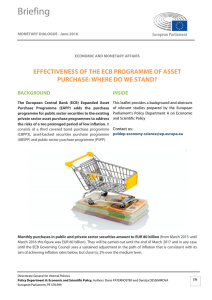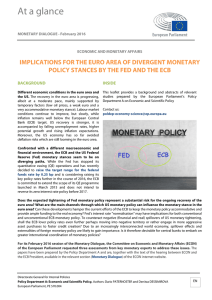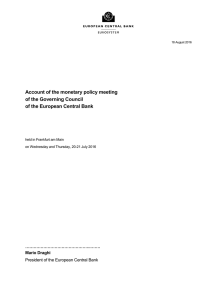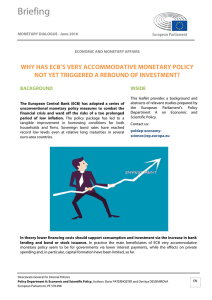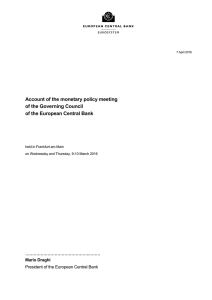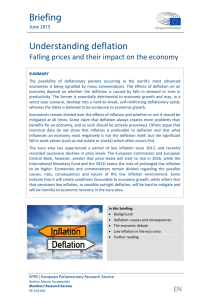Account of the monetary policy meeting of the Governing Council of
Anuncio
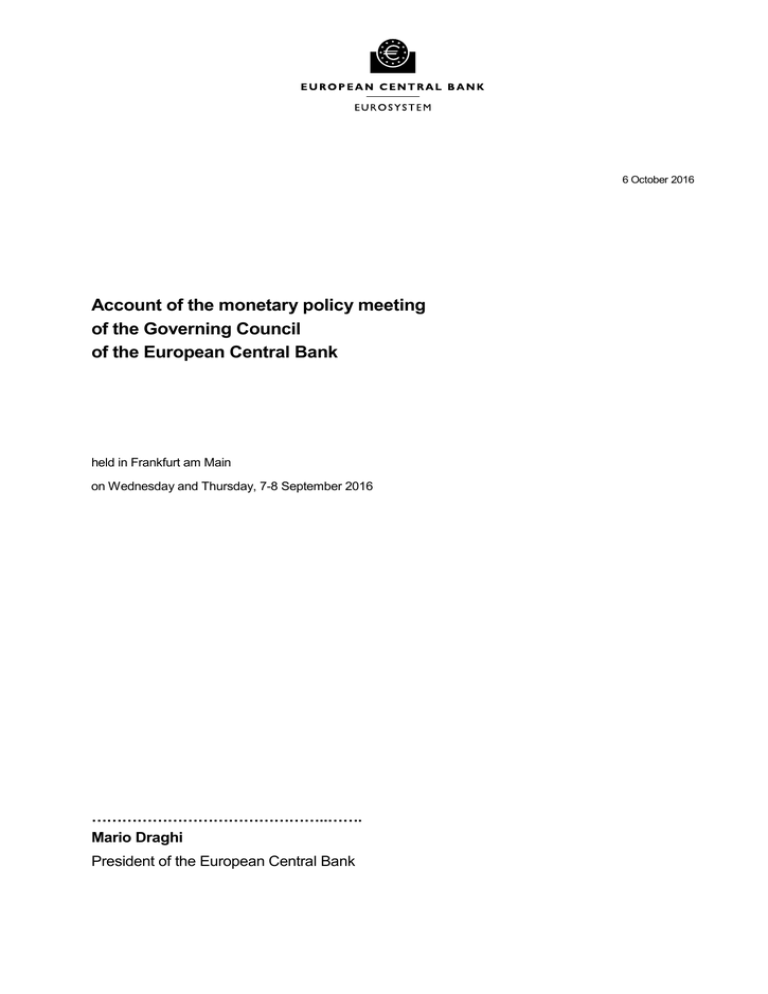
6 October 2016 Account of the monetary policy meeting of the Governing Council of the European Central Bank held in Frankfurt am Main on Wednesday and Thursday, 7-8 September 2016 ………………………………………..……. Mario Draghi President of the European Central Bank 1. Review of financial, economic and monetary developments and policy options Financial market developments Mr Cœuré reviewed the latest financial market developments. Since the Governing Council’s previous monetary policy meeting on 20-21 July 2016, sentiment in the financial markets had improved and volatility had declined. Global equity indices had fully recovered from the decline seen at the time of the UK referendum and, by early September, had risen to stand close to their highest levels in 2016, supported by better than expected economic news in some of the main economic regions and by expectations of further monetary policy easing. While the European bank equity index had been supported by the generally positive market sentiment through July and August, it remained below the levels seen at the start of the year. The release of the European Banking Authority’s stress test results had not had any significant impact on the performance of bank equities. Turning to oil prices, Brent crude oil had recovered when OPEC members started suggesting that they were prepared to discuss stabilising prices at the forthcoming informal OPEC meeting in September. The implementation of the asset purchase programme (APP) across all components had continued in a satisfactory way in recent months. This was the case despite the usual lower market liquidity in summer, which had been factored in by lower targeted purchase volumes for July and August. The start of the implementation of the corporate sector purchase programme (CSPP) had been very smooth, underpinned by an active primary market and good liquidity conditions in the secondary market. As a result, the total portfolio size of the CSPP had already overtaken that of the asset-backed securities purchase programme (ABSPP). The total size of the Eurosystem balance sheet, at €3.35 trillion, now exceeded the peak of €3.1 trillion reached in July 2012, while overall market liquidity indicators did not point to emerging problems in the functioning of the cash bond market. However, the footprint of the purchase programmes in the market had increased, due to both the larger volume of monthly purchases since April and declining market activity over the summer months. In addition, borrowing rates for some government bond collateral had deviated from ECB policy rates, highlighting increasing scarcity of some bonds, which may be explained by several factors, such as higher demand for certain types of investment. While the implementation of the APP was continuing to progress smoothly overall, the present constellation of interest rates was posing increasing challenges to implementation in the future. The funding situation of European banks had remained robust in spite of market concerns. Regarding US dollar funding conditions, the spread between US dollar LIBOR and the US dollar overnight index swap rate had increased by 10 basis points since mid-July, as money markets were pricing in a lower availability of US dollar liquidity for banks, related to the implementation of the US money market fund reform in October 2016. Page 2 There were no signs of US funding tensions for euro area banks and the recourse to the Eurosystem’s US dollar operations had remained limited. The global environment and economic and monetary developments in the euro area Mr Praet reviewed the global environment and recent economic and monetary developments in the euro area. Global growth continued to be sluggish. The global composite output Purchasing Managers’ Index (PMI) had risen to 51.6 in August, from 51.5 in July, on the back of a slightly stronger expansion in both the manufacturing and services sectors, although developments had remained mixed both across and within advanced economies and emerging market economies. In the United Kingdom, following the referendum outcome in June, short-term indicators had been more resilient than previously expected, while uncertainty remained high as regards the longer-term economic outlook. Annual consumer price inflation in the OECD area had dropped slightly in July, to 0.8%, from 0.9% in June. Excluding food and energy, inflation had declined to 1.8% in July, from 1.9% in June. Brent crude oil prices had stood at USD 47 per barrel on 6 September, 3.1% higher than at the time of the 20-21 July Governing Council meeting. Over the same period, the euro had remained broadly unchanged in nominal effective terms vis-à-vis the currencies of 38 of the euro area’s major trading partners. Turning to the euro area, real GDP had increased by 0.3%, quarter on quarter, in the second quarter of 2016, after 0.5% in the first quarter, with positive contributions from net exports and, to a lesser extent, domestic demand. The composite output PMI had stood, on average, at 53.1 in July and August, the same level as in the second quarter, while the European Commission’s Economic Sentiment Indicator (ESI) had displayed a small decline as a result of a pronounced fall in August. Both indicators – the PMI and the ESI – remained above their respective long-term averages. Quarterly growth in private consumption had slowed in the second quarter, while labour markets had continued to improve and households’ real disposable income had increased further. Employment had risen by 0.3%, quarter on quarter, in the first quarter and the euro area unemployment rate, at 10.1% in July, unchanged from June, had remained at its lowest level since August 2011. Surveys up to August 2016 suggested further labour market improvements in the period ahead. Total investment had been flat in the second quarter, while domestic conditions remained, overall, supportive for investment. The latest quarterly European Commission Business Surveys that were released on 29 July showed that capacity utilisation in the manufacturing sector had increased slightly and that demand had improved further to a level not seen since early 2012. However, falling confidence and export orders in total manufacturing suggested weaker business investment growth looking ahead. At the same time, low interest rates in the euro area significantly reduced debt servicing costs, thereby supporting the profitability of nonfinancial corporations (NFCs). Page 3 Looking ahead, in the September 2016 macroeconomic projections ECB staff expected euro area real GDP to grow by 1.7% in 2016 and by 1.6% in 2017 and 2018. Compared with the June 2016 Eurosystem staff projections, the outlook for growth had been revised downwards slightly for both 2017 and 2018. Turning to euro area price developments, according to Eurostat’s flash estimate annual HICP inflation had been 0.2% in August, unchanged from July. While annual energy inflation had continued to rise, services and non-energy industrial goods inflation had turned out to be slightly lower than in July. At the same time, underlying inflation was not yet showing any clear sign of an upward trend. Following an increase in the first half of 2015, the annual rate of the HICP excluding food and energy had been hovering around 1%. Producer price inflation for domestic sales of non-food consumer goods had remained unchanged at 0.0% in July. While some improvement in economic conditions had probably exerted upward pressure on producer prices, it had likely been offset by low commodity input prices. Looking ahead, signs of upward pressure came from the services sector. Moreover, selling price expectations had continued to show an upward trend, with the European Commission survey indicator standing above its long-term average since the beginning of 2016. Wage growth in the euro area had stabilised at a low level. Looking ahead, in the September 2016 macroeconomic projections ECB staff foresaw annual HICP inflation at 0.2% in 2016, 1.2% in 2017 and 1.6% in 2018. These projections were broadly in line with those from the private sector and other international organisations. As regards longer-term inflation expectations, survey-based measures had remained stable since the beginning of the year. According to the ECB’s Survey of Professional Forecasters for the third quarter of 2016, average longer-term expectations for inflation five years ahead continued to stand at 1.8%. By contrast, looking at market-based inflation expectations, the euro area five-year forward inflation-linked swap rate five years ahead had decreased further, from 1.36% on 19 July 2016, to stand at 1.26% on 6 September. Financial market participants continued to assume that medium-term inflation would stay low, with the probability of inflation remaining between only 0% and 1.5% increasing again since the UK referendum. At the same time, deflation fears in the market appeared well contained and had not returned to the levels observed in late 2014 and early 2015. With regard to financial conditions, the situation had remained broadly unchanged from the 20-21 July Governing Council meeting. The EONIA forward yield curve remained well below levels that had been observed in early June 2016, while the GDP-weighted average of ten-year euro area sovereign bond yields had mostly stayed between 0.5% and 0.6%. Moreover, financial market volatility had remained low and NFC equity indices were trading above levels that had prevailed at the beginning of June. At the same time, a further decline in corporate bond yields, amid rising monthly gross issuance of corporate bonds, had been observed since the announcement of the CSPP in March. The cost to euro area banks of debt funding had also continued to fall and to converge across countries towards very low levels. Moreover, banks had seen a further decrease in the cost of deposits and of Eurosystem funding, particularly via TLTRO-II. Bank lending rates to households and NFCs had continued to decline in the second quarter of 2016 and in July. At the same time, retail deposit rates across the euro area had stabilised at very low levels. Financing conditions for households and firms had improved slightly overall. Page 4 The total annual flow of external financing to euro area NFCs continued to strengthen in the second quarter of 2016. Current levels were comparable with those of 2005 and 2009, being mainly driven by the ample issuance of market debt. Together with the ongoing recovery in loans to NFCs from banks and non-banks, these developments pointed to improved access to external financing by both larger and smaller firms and were expected to provide further support to the ongoing euro area recovery. Turning to money and credit, annual growth in M3 had remained broadly unchanged at 4.8% in July 2016 – now hovering close to 5% for over a year – while the annual growth rate of MFI loans to the private sector had continued its gradual recovery, reaching 1.7% in July, up from 1.5% in June. The annual growth rate of loans to NFCs had risen to 1.7% in June, at the end of the second quarter of 2016, up from 1.1% in the previous quarter, reaching 1.9% in July. The annual growth rate of loans to households had also continued to increase from the first to the second quarter, standing at 1.8% in July. Bank profitability remained low, while bank equity prices had performed poorly over the past year, reflecting financial market uncertainty and low economic growth, also in a context of regulatory challenges. The gap between euro area banks’ cost of equity and return on equity was estimated to have widened further recently, while price-to-book ratios of euro area banks had remained stable and continued to stand significantly below 1. With regard to fiscal policies, the fiscal stance in the euro area, as measured by the change in the cyclically adjusted primary balance, was expected to be mildly expansionary in 2016 and to turn broadly neutral in 2017 and 2018. Monetary policy considerations and policy options Summing up, Mr Praet recalled that, at its meeting on 20-21 July 2016, the Governing Council had concluded that, following the UK referendum, more information would be needed to reassess the underlying macroeconomic conditions. Incoming data continued to point to the resilience of the euro area economy to global and political uncertainty, although downside risks remained. The ECB’s comprehensive monetary policy measures continued to ensure supportive financing conditions and were underpinning the euro area economic recovery. The September 2016 ECB staff projections continued to expect real GDP to grow at a moderate pace, albeit slightly slower than previously anticipated. The outlook for euro area HICP inflation was broadly unchanged, in line with the path already embodied in the June 2016 Eurosystem staff projections. Over the coming months HICP inflation was expected to pick up, in large part owing to base effects. Yet, underlying price pressures continued to lack a convincing upward trend and remained an ongoing source of concern. Importantly, the projected path of inflation remained conditional on exceptionally supportive financing conditions, which to a large extent reflected the ECB’s accommodative monetary policy. Developments in the bank lending channel deserved close monitoring. The pass-through of the ECB’s measures to borrowing conditions remained strong, but banks faced numerous challenges that might affect both their pricing and lending decisions. Page 5 With these considerations in mind, and on the basis of available information, preserving the very substantial amount of monetary support embedded in the staff projections was necessary to secure a return of inflation rates to levels below, but close to, 2% over the medium term. As regards implementation, there had to be no doubt about the Governing Council’s ability to act if needed. In this respect, the relevant committees should be tasked to evaluate options that ensured a smooth implementation of the APP. Potential revisions of the parameters had to take due consideration of their effectiveness from a monetary policy perspective. Against this backdrop, communication needed to emphasise that monetary policy measures had been instrumental in ensuring the resilience of the euro area economy to global and political uncertainty. It was also important to reiterate that the Governing Council continued to monitor economic and financial market developments very closely and that it was determined to preserve the required degree of accommodation, as appropriate, to secure a return of inflation to its inflation aim. Likewise, it was important to restate that the Governing Council stood ready to use all the instruments within its mandate to achieve its objective of price stability, and to re-emphasise that, to reap the full benefits from the ECB’s monetary policy measures, other policy areas needed to contribute decisively and in a timely manner. 2. Governing Council’s discussion and monetary policy decisions Economic and monetary analyses With regard to the economic analysis, there was broad agreement among the members with the assessment, provided by Mr Praet in his introduction, of the outlook and risks for economic activity in the euro area. Real GDP growth had continued in the second quarter, albeit at a lower rate than in the first quarter, in line with expectations. Recent data releases remained consistent with a continuation of the moderate economic recovery also in the third quarter. Looking further ahead, domestic demand in the euro area was expected to remain resilient, supported by still relatively low oil prices, as well as by the pass-through of the ECB’s monetary policy measures. Growth prospects were seen to be dampened by continuing subdued foreign demand, partly related to the uncertainties surrounding the outcome of the UK referendum, as well as by the necessary balance sheet adjustments in a number of sectors and a sluggish pace of implementation of structural reforms. This assessment was reflected in the outlook for growth in the September 2016 ECB staff macroeconomic projections. Compared with the June 2016 Eurosystem staff projections, the growth outlook had been revised downwards slightly. Commenting in more detail on the outlook for and risks to the external environment, members noted that the latest staff projections did not contain a deterioration in the outlook for emerging market economies. At the same time, it was remarked that the staff projections had incorporated a substantial downward revision to euro area foreign demand, which largely reflected a lower growth and trade outlook for the United Kingdom in the wake of the referendum vote to leave the European Union. Members took note that the financial market reaction to the outcome of the referendum had been contained. There was also some evidence, from recent Page 6 UK data releases, to suggest that the immediate effect on activity of the referendum result might be less negative than had been widely expected. At the same time, it was emphasised that there was considerable uncertainty surrounding the longer-term economic implications of the UK vote, as regards the impact both on the UK economy and on trade with the European Union. It was considered too early to say that the widely expected adverse effects on growth were overstated, while the monetary policy measures taken by the Bank of England, together with expectations of further policy measures, were seen as helping to buffer the adjustment of the UK economy. Thus, there remained a risk that, at some point, stronger downside effects of the UK decision to leave the European Union would manifest themselves. Overall, there was broad agreement that the outlook for the external environment continued to be uncertain and subject to downside risks. Turning to the euro area, there was broad agreement with the growth outlook embodied in the September 2016 ECB staff projections. The latter confirmed that the moderate recovery in the euro area economy was ongoing, with only small downward revisions to the outlook for 2017 and 2018, which were related to external, rather than domestic, factors. It was noted that the latest data for the euro area were consistent with an ongoing economic recovery, with business and consumer confidence remaining robust over the summer months. It was highlighted that the euro area had recorded positive quarter-on-quarter growth rates for more than three years, starting in the second quarter of 2013, which was evidence of the resilience of the euro area recovery to global economic and political uncertainty. In considering the latest staff projections, members observed that the expected negative effect of the UK referendum outcome on the euro area economy via trade channels had been offset by other factors, notably a decline in government bond yields and a slightly lower effective exchange rate of the euro. It was underlined that the projections were based on exceptionally supportive financing conditions, which to a large extent reflected the ECB’s accommodative monetary policy. It was also noted that market expectations of additional monetary policy measures by the ECB were reflected in the technical assumptions underlying the September 2016 staff projections for growth and inflation. This limited the extent to which the baseline was revised downwards. However, overall, the positive impact of these expectations on the baseline was assessed to be contained and had to be viewed in the context of the high degree of uncertainty which, in any case, surrounded the outlook for growth and inflation, including uncertainty about the impact of non-standard measures. When discussing the components of domestic spending, members observed that consumption was being supported by higher real household disposable income, related to sustained employment gains and still relatively low oil prices, while favourable financing conditions, together with improvements in corporate profitability and in the outlook for demand, should support a recovery in investment looking ahead. However, some concern was again expressed about the prospects for a pick-up in investment, also taking into account its weakness in the second quarter. Members felt that the reasons behind the hesitant recovery in business investment needed to be better understood in conjunction with persistently high corporate savings, the role of uncertainty and other factors, such as technology and demographic developments. Attention was drawn to the fact that cross-country developments were uneven. It was pointed out that, while output growth in some countries had exceeded expectations, the level of GDP in other countries was still very Page 7 low relative to pre-crisis levels. It was suggested that the structural reasons behind consistent sub-par performance should be further examined, and overall it was noted that there was still some way to go to reach sustainable convergence among euro area countries. Reference was also made in the discussion to the continued existence of savings and investment imbalances at the euro area and country levels. The euro area current account surplus, reflecting an excess of domestic saving over investment, was seen as an indication of weak domestic demand. At the same time, it was pointed out that in some small euro area countries stronger domestic demand had mainly led to higher import growth. Moreover, structural factors such as demographics were also deemed to play a role in explaining patterns in national savings and current account balances. Overall, the recovery in the euro area economy was expected to continue at a moderate but steady pace, while the risks to the growth outlook were assessed to remain tilted to the downside, related mainly to the external environment. Against this background, members again stressed that monetary policy on its own was not sufficient for a selfsustaining recovery, and that there was a need for other policy areas to contribute much more decisively in supporting economic activity and potential growth. Structural reforms were necessary in all euro area countries, and implementation needed to be stepped up substantially in order to reduce the level of structural unemployment and to raise potential growth. The focus should be on actions to raise productivity and improve the business environment, including the provision of adequate public infrastructure. Higher public and private investment was considered important to raise productivity growth. The swift and effective implementation of structural reforms would not only lead to higher sustainable economic growth in the euro area, but would also make the euro area more resilient to external shocks. Turning to fiscal policy, members highlighted the need for compliance with the fiscal rules of the European Union and reiterated that full and consistent implementation of the Stability and Growth Pact over time and across countries remained crucial for confidence in the fiscal framework, which was increasingly being challenged. Concerns were expressed with regard to recent decisions at the European level that cast doubt on the functioning of the Pact. At the same time, it was also recalled that a more growth-friendly composition of fiscal policies could support the economic recovery, as could the use of fiscal space, where available. It was stressed that the composition of government expenditure was at least as important as its size. With regard to price developments, there was broad agreement with the assessment presented by Mr Praet in his introduction. Headline inflation was expected to start rising in the coming months, owing to upward base effects from energy prices and assumed oil price increases embedded in the futures curve. Over the projection horizon, inflation was expected to pick up further, supported by the ECB’s monetary policy measures and in line with the projected economic recovery. This assessment was reflected in the September 2016 ECB staff projections, where the HICP inflation outlook was broadly unchanged in comparison with the June 2016 Eurosystem staff projections. In discussing expected developments in inflation, members noted that there was still no clear upward trend visible in measures of underlying inflation, which remained low. According to the latest staff projections, HICP Page 8 inflation excluding food and energy and headline inflation were expected to converge in early 2017, at rates slightly above 1%. With regard to the prospect of a further increase in inflation beyond this period, it was suggested that an important role would probably be played by services price inflation, as non-energy industrial goods prices were likely to continue to be affected by globalisation and could therefore be expected to remain subdued. The expectation of higher services price inflation was supported by evidence linking developments in services prices with wage growth, and by the expectation of more dynamic wage developments. It would thus be important to continue to follow developments in wages closely. In this context, it was noted that the projections expected a further decline in the unemployment rate to be only gradual, which might understate the cyclical effect on the labour market of the ongoing recovery in activity. A number of remarks were made in relation to the risks surrounding the increase in inflation expected in the September 2016 staff projections. In particular, reference was made to the past sequence of over-predictions in the inflation projections, which was seen as a downside risk to the baseline. Concern was expressed that the standard models used to produce inflation forecasts were typically subject to mean-reversion, and it was noted that analysis of the inflation outlook using a range of Phillips curves suggested that the projections, although within a plausible range, could be considered optimistic. The remark was also made that persistently low inflation in the euro area might start to affect expectations and make it harder for countries to regain competitiveness via relative price and wage adjustment, as well as contribute to higher real interest rates and a higher real debt burden, thereby dampening economic growth and inflation prospects. However, it was also argued that there were good reasons to think that the past projection errors for inflation might not be repeated in the future. The impact of labour market reforms, which might have dampened wage pressures in the past, would fade over time and the effect of nominal rigidities, which had prevented sharp corrections in wages during the crisis and led to a more protracted wage adjustment, should also diminish. Moreover, there was a composition effect on wages, linked to job creation in low productivity and low wage sectors, which was unlikely to continue. It was also noted that oil prices were subject to considerable volatility and it was not easy to predict where they would stand in 2018. According to oil price futures, oil prices in 2018 would still be below their 2015 level. It could thus be argued that there was a risk that oil prices would be higher than assumed in the projections and that energy price inflation might increase more than currently projected. Members also considered recent developments in inflation expectations. It was highlighted that survey-based measures of longer-term inflation expectations, such as the ECB’s Survey of Professional Forecasters, were broadly unchanged for the period five years ahead, at around 1.8%. However, while the average of point forecasts was stable, the Survey of Professional Forecasters also provided a probability distribution around the point forecasts which remained tilted to the downside. There had been a further decline in market-based inflation expectations for the euro area since the Governing Council’s previous monetary policy meeting, the five-year forward inflation-linked swap rate five years ahead having fallen to around 1.3%. This warranted close monitoring. It was also noted, however, that the probability of deflation had not increased and that market expectations were affected by international, as well as domestic, developments. Moreover, it could not be Page 9 ruled out that there might be some small positive effects on longer-term market expectations if actual inflation started to increase in the coming months. Overall, there was broad agreement that euro area inflation was expected to rise over the months ahead and that the outlook for inflation was broadly unchanged compared with the path implied in the June 2016 staff projections. With regard to the monetary analysis, members concurred with the assessment presented by Mr Praet in his introduction. Broad money (M3) had continued to increase at a robust pace in July 2016. As in previous months, annual growth in M3 had been mainly supported by its most liquid components and loan dynamics had continued on the path of gradual recovery observed since the beginning of 2014. Members stressed that the effects of the monetary policy measures in place since June 2014 were continuing to filter through to support borrowing conditions for firms and households and, thereby, credit flows across the euro area. In particular, the continued easing in market-based financing conditions, including banks’ funding conditions, together with strong competitive pressure among lenders, had all contributed to a further decline in bank lending rates, including vis-à-vis small and medium-sized enterprises. While the credit channel had continued to improve, bank loan dynamics still remained moderate overall despite the substantial degree of monetary accommodation. Therefore, given the banking system’s crucial importance for the transmission of monetary policy to the broader economy, developments in the bank lending channel continued to deserve close monitoring, as had been pointed out by Mr Praet in his introduction. Ongoing structural challenges related to banks’ balance sheets and the weakness in profitability continued to pose a risk to the transmission of monetary policy and the further recovery in credit dynamics. While bank earnings had been lower in the first quarter of 2016 than in the first quarter of 2015 (when banks had benefited from valuation gains associated with the launch of the expanded APP), net interest income had still been holding up relatively well. However, more recent indications pointed to a further decline in all three main revenue pillars, namely interest income, non-interest fee income and trading income. While this could, in part, be attributed to the low interest rate environment, lower bank earnings were also due to provisioning related to the still high level of non-performing loans in parts of the euro area banking sector and increased competition among banks. Looking ahead, further challenges could arise from regulatory and supervisory demands on banks in the coming months. At the same time, it was seen as important for the Governing Council to counter prevailing misperceptions regarding adverse implications for the banking sector of regulatory measures and supervisory action aimed at ensuring its stability and balance sheet sustainability. In this regard, it was of paramount importance to address the remaining structural weaknesses in the euro area banking sector, where in particular bank lending should benefit from dealing effectively with non-performing exposures. A healthier banking system should further support money and credit creation and enhance the effectiveness of the monetary policy measures in place. In this context, it was also highlighted that bank profitability depended crucially on the further recovery in the euro area economy supporting an increase in still sluggish credit demand. Page 10 As had already been noted at the Governing Council’s previous monetary policy meeting, the continued underperformance of bank equity prices, also reflecting dampened earnings expectations, had kept the cost of bank equity at elevated levels and might contain a cautionary signal for future loan growth. While there appeared to be a close correlation between bank equity valuations and the growth rate of aggregate credit in the subsequent year, it was considered difficult, however, to establish a clear causal link, as a number of supply and demand factors played a role in determining bank equity prices and bank lending. Monetary policy stance and policy considerations With regard to the monetary policy stance, members widely shared the assessment provided by Mr Praet in his introduction that the incoming data continued to point to the euro area economy’s resilience to global and political uncertainty. Accordingly, and based on supportive financing conditions, real GDP was expected to grow at a moderate but steady pace and euro area inflation to rise gradually in line with the path already embodied in the June 2016 Eurosystem staff projections. Yet, downside risks remained and underlying inflation was still not showing convincing signs of a sustained pick-up, which warranted continued close monitoring of price trends and of economic and financial market developments. Members widely agreed that policy action at the present meeting was not warranted and that the focus should remain on ensuring the full implementation of the policy measures so far decided. It was therefore seen as important to confirm the Governing Council’s commitment to the monthly asset purchases of €80 billion, which were intended to run until the end of March 2017, or beyond, if necessary, and in any case until the Governing Council saw a sustained adjustment in the path of inflation consistent with its inflation aim. The comprehensive set of policy measures that had been adopted were seen as continuing to support favourable market and bank-based financing conditions. In particular, the recently commenced CSPP and TLTRO-II were providing further significant funding cost relief to both non-financial corporations and banks. Moreover, market fragmentation had, overall, diminished markedly, contributing to improvements in monetary policy transmission across the euro area. Reference was made to the ongoing reduction in emergency liquidity assistance to banks in vulnerable euro area countries and the continued decline in spreads across euro area credit markets. However, cross-country differences in spreads were also seen to reflect still prevailing differences in country-specific credit risk premia. While the substantial degree of monetary accommodation was swiftly reflected in financial market conditions, it had not yet completely filtered through to final variables such as growth and inflation. It was recalled, however, that transmission lags, with which policy passed through intermediate variables to the ultimate objective, had to be taken into account. Moreover, in view of the private and public sector imbalances that had built up previously, these lags were likely to be longer than usual, and it would still take more time for the effects of the ECB’s policy measures to unfold fully and reach the broader economy. Overall, confidence was expressed that the monetary policy measures were continuing to provide effective support to the cyclical recovery and the upward path in inflation. This was also reflected in the September 2016 ECB staff projections, in which the measures taken in December 2015 and March 2016 were estimated Page 11 to have a cumulated upward impact on real GDP growth of 0.6 percentage point and on inflation of 0.4 percentage point over the projection horizon. In this context, it was highlighted that the projected path of inflation was conditional on exceptionally supportive financing conditions, which to a large extent reflected the current accommodative monetary policy stance and prevailing market expectations about the future course of monetary policy. Against this background, and given remaining downside risks and uncertainties relating, in particular, to the external environment, the view was widely shared that financing conditions had to remain supportive to underpin the recovery in growth and inflation. It was therefore of crucial importance to preserve the very substantial degree of monetary support that was embedded in the staff projections, while it was also cautioned that the Governing Council should not be unduly influenced by prevailing market expectations and that it had to remain fully focused on its commitment to achieve its price stability objective over the medium term. At the same time, members reiterated their full commitment to bringing inflation back to levels in line with the Governing Council’s medium-term aim without undue delay. While the Governing Council needed to stay the course at the present meeting and give existing measures time to unfold, it was important to reiterate its capacity and readiness to act, if warranted, to achieve its objective, using all the instruments available within its mandate. Members also discussed possible future challenges regarding the Eurosystem’s ability to source sufficient eligible bonds in the market under the APP and the request was made to the relevant Eurosystem committees to further evaluate the options to ensure smooth implementation of the programme. The view was widely shared that reassurance had to be provided about the Eurosystem’s ability to ensure the smooth implementation of the APP and its capacity to deliver on its commitment that the programme would run until March 2017, or beyond, if needed. It was underlined that the Governing Council could adjust the parameters of the programme at any time to achieve the intended amounts. There should be no doubt about the Governing Council’s determination to execute its asset purchases in line with its past decisions and to adopt further measures, if needed, to fulfil its price stability objective. Finally, a strong call was made for European policymakers to flank the ECB’s accommodative monetary policy measures with adequate fiscal policies and structural reforms to achieve strong, sustainable and balanced growth in line with the G20 policy commitments. Monetary policy alone could not lead to sustainable growth but could only buy time for action to be taken in other policies areas. To reap the full benefits of an extraordinarily accommodative monetary policy in supporting growth and inflation, other policies needed to contribute decisively. Monetary policy decisions and communication As regards communication, members widely agreed with the proposals presented by Mr Praet in his introduction. Confidence had to be conveyed in the effectiveness of the ECB’s monetary policy measures and the state of the euro area economy, its resilience to global uncertainty and the baseline scenario for growth and inflation. In the light of the prevailing uncertainties, it was also seen as important to reiterate that the Page 12 Governing Council was monitoring economic and financial market developments very closely and that it was determined to preserve the very substantial degree of monetary accommodation that was necessary to secure a return of inflation to levels below, but close to, 2% over the medium term. Finally, great emphasis had to be placed on the Governing Council’s willingness, capacity and ability to act, if warranted, to achieve its objective by using all the instruments available within its mandate. Taking into account the foregoing discussion among the members, on a proposal from the President, the Governing Council decided to keep the interest rates on the Eurosystem’s main refinancing operations, the marginal lending facility and the deposit facility unchanged at 0.00%, 0.25% and -0.40% respectively. The Governing Council continued to expect the key ECB interest rates to remain at present or lower levels for an extended period of time, and well past the horizon of the net asset purchases. Regarding non-standard monetary policy measures, the Governing Council confirmed that the monthly asset purchases of €80 billion were intended to run until the end of March 2017, or beyond, if necessary, and in any case until it saw a sustained adjustment in the path of inflation consistent with its inflation aim. The members of the Governing Council subsequently finalised the introductory statement, which the President and the Vice-President would, as usual, deliver at the press conference following the end of the current Governing Council meeting. Introductory statement http://www.ecb.europa.eu/press/pressconf/2016/html/is160908.en.html Press release http://www.ecb.europa.eu/press/pr/date/2016/html/pr160908.en.html Page 13 Meeting of the ECB’s Governing Council, 7-8 September 2016 Members Mr Draghi, President Mr Constâncio, Vice-President Mr Cœuré Mr Costa Ms Georghadji Mr Hansson Mr Jazbec Mr Knot Mr Lane Ms Lautenschläger Mr Liikanen Mr Linde (*) Mr Makúch Mr Mersch Mr Nowotny (*) Mr Praet Mr Reinesch (*) Mr Rimšēvičs Mr Smets Mr Stournaras Mr Vasiliauskas Mr Vella (*) Mr Villeroy de Galhau Mr Visco Mr Weidmann (*) Members not holding a voting right in September 2016 under Article 10.2 of the ESCB Statute. Other attendees Mr Dombrovskis, Commission Vice-President (**) Mr Teixeira, Secretary, Director General Secretariat Mr Winkler, Deputy Secretary for monetary policy, Senior Adviser, DG Economics (**) In accordance with Article 284 of the Treaty on the Functioning of the European Union. Page 14 Accompanying persons Ms Buch Mr Dolenc Mr Fagan Mr Gaiotti Mr Hernández de Cos Mr Kaasik Mr Kuodis Ms Le Lorier Mr Mifsud Mr Mooslechner Mr Ramalho Mr Rutkaste Mr Schoder Mr Stavrou Mr Swank Mr Tavlas Mr Tóth Mr Välimäki Mr Wunsch Other ECB staff Ms Graeff, Director General Communications Mr Smets, Counsellor to the President Mr Bindseil, Director General Market Operations Mr Klöckers, Deputy Director General Economics Mr Rostagno, Director Monetary Policy, DG Economics Release of the next monetary policy account foreseen on Thursday, 17 November 2016. Page 15
